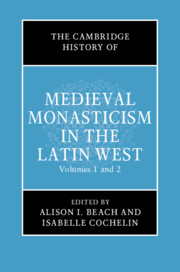Book contents
- The Cambridge History of Medieval Monasticism in the Latin WEST
- The New Cambridge History of Medieval Monasticism in the Latin West
- The Cambridge History of Medieval Monasticism in the Latin WEST
- Copyright page
- Contents
- Figures
- Contributors
- Acknowledgments
- Abbreviations
- 1 General Introduction
- Part I The Origins of Christian Monasticism to the Eighth Century
- Part II The Carolingians to the Eleventh Century
- Part III The Long Twelfth Century
- Part IV Forms of Monasticism in the Late Middle Ages
- 50 Late Medieval Monasticism: Historiography and Prospects
- 51 Sources of Late Medieval Monasticism
- 52 Monastic Liturgy, 1100–1500: Continuity and Performance
- 53 Books and Libraries within Monasteries
- 54 Art in Monastic Churches of Western Europe from the Twelfth to the Fourteenth Century
- 55 Lay Brothers and Sisters in the High and Late Middle Ages
- 56 Female Religious Life in the Twelfth and Thirteenth Centuries
- 57 Striving for Religious Perfection in the Lay World of Northern Europe
- 58 Monks and the Universities, c. 1200–1500
- 59 Bishops, Canon Law, and the Religious, c. 1140–1350
- 60 Daily Life in Late Medieval Monasteries
- 61 Monastic Preaching, c. 1350–1545
- 62 Research on Monasticism in the German Tradition
- 63 Satirical Depictions of Monastic Life
- 64 A Crisis of Late Medieval Monasticism?
- Index
- References
53 - Books and Libraries within Monasteries
from Part IV - Forms of Monasticism in the Late Middle Ages
Published online by Cambridge University Press: 16 January 2020
- The Cambridge History of Medieval Monasticism in the Latin WEST
- The New Cambridge History of Medieval Monasticism in the Latin West
- The Cambridge History of Medieval Monasticism in the Latin WEST
- Copyright page
- Contents
- Figures
- Contributors
- Acknowledgments
- Abbreviations
- 1 General Introduction
- Part I The Origins of Christian Monasticism to the Eighth Century
- Part II The Carolingians to the Eleventh Century
- Part III The Long Twelfth Century
- Part IV Forms of Monasticism in the Late Middle Ages
- 50 Late Medieval Monasticism: Historiography and Prospects
- 51 Sources of Late Medieval Monasticism
- 52 Monastic Liturgy, 1100–1500: Continuity and Performance
- 53 Books and Libraries within Monasteries
- 54 Art in Monastic Churches of Western Europe from the Twelfth to the Fourteenth Century
- 55 Lay Brothers and Sisters in the High and Late Middle Ages
- 56 Female Religious Life in the Twelfth and Thirteenth Centuries
- 57 Striving for Religious Perfection in the Lay World of Northern Europe
- 58 Monks and the Universities, c. 1200–1500
- 59 Bishops, Canon Law, and the Religious, c. 1140–1350
- 60 Daily Life in Late Medieval Monasteries
- 61 Monastic Preaching, c. 1350–1545
- 62 Research on Monasticism in the German Tradition
- 63 Satirical Depictions of Monastic Life
- 64 A Crisis of Late Medieval Monasticism?
- Index
- References
Summary
To Jerome of Mondsee (d. 1475), master of the University of Vienna and proponent of the Melk reform, the omnipresence of books within monasteries was self-evident. He expressed this sentiment in the title of his short work “Remarks that religious should have table readings, not only in the refectory, but also in other places (within the monastery).” Reading aloud was thought to make the contents of a text more accessible, individual reading to promote introspection, and above all, to encourage compliance with the rule of silence, since reading aloud to one’s self was not the same as talking. Humbert of Romans (1200–77), Dominican master general, wrote in his instructions for the various offices of the order that the librarian was to open the library regularly, but also to ensure that the books that most of the brothers did not personally possess were located in “appropriate places of silence,” usually chained to desks.
- Type
- Chapter
- Information
- The Cambridge History of Medieval Monasticism in the Latin West , pp. 975 - 997Publisher: Cambridge University PressPrint publication year: 2020
References
- 2
- Cited by



